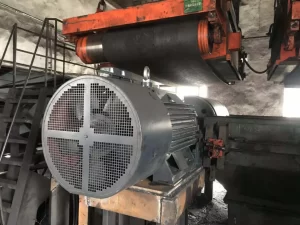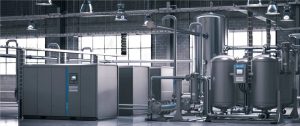A permanent magnet (PM) motor is an AC motor that utilizes magnets either embedded within the surface of the rotor or attached to it. PM motors can be categorized into two main structures: interior and surface, each with its own subcategories. In the case of a surface PM motor, magnets can be positioned on or inset into the surface of the rotor, enhancing the durability of the motor’s design. On the other hand, the positioning and design of magnets in an interior permanent magnet (IPM) motor can exhibit significant variation. The magnets in an IPM motor can be inset as a large block or staggered as they approach the core, while another approach involves embedding them in a spoke pattern.
 What is induction motors?
What is induction motors?An induction motor, also referred to as an asynchronous motor, is a widely used AC electric motor. It operates by utilizing electromagnetic induction from the rotating magnetic field of the stator winding to induce the electrical current required in the rotor for generating torque. The rotor of an induction motor can be either a squirrel cage rotor or a wound type rotor.
In this motor, the flux emanating from the stator interacts with the short-circuited coil within the rotor. As per Faraday’s law of electromagnetic induction, the presence of the magnetic field induces a current flow in the rotor coil. The rotor coils, being short-circuited, allow the current to circulate through them. Consequently, the current flow within the rotor coils triggers the creation of another magnetic flux within the rotor.
Now there are two fluxes, one is stator flux, and another is rotor flux. The rotor flux will be lagging with respect to the stator flux. Because of that, the rotor will feel a torque which will make the rotor to rotate in the direction of the rotating magnetic field. This is the working principle of both single and three-phase induction motors.
Induction motors operate based on the fundamental principle of electromagnetic induction. They consist of stationary windings, known as the stator, that generate a magnetic field. This rotating magnetic field induces currents in the rotor windings, leading to the generation of torque necessary for motor function.
On the other hand, permanent magnet motors utilize permanent magnets, often composed of materials like neodymium, to establish a steady magnetic field. This fixed magnetic field interacts with the currents in the rotor windings, resulting in the production of the required torque to drive the motor.

Induction motors are comprised of a stator equipped with three-phase windings, along with a rotor that can either be of the squirrel cage or wound rotor type. On the other hand, permanent magnet motors share a resembling stator configuration to induction motors, but their rotor incorporates permanent magnets instead.
Permanent magnet motors exhibit high efficiency since they lack the rotor losses typically found in induction motors, including losses from rotor copper and rotor iron. On the other hand, induction motors tend to have comparatively lower efficiency due to losses occurring in their rotor windings.
ENNENG, as a premier provider of Permanent Magnet Motors (PMM) in China, takes pride in its market-leading PMM offerings. These products stand out for their exceptional efficiency and multi-faceted applications. As an enterprise focusing solely on the design and production of permanent magnet motors, ENNENG consistently strives to furnish customers with reliable and high-performance motor solutions.
ENNENG’s permanent magnet motor products utilize advanced permanent magnet materials and technologies, which offer many advantages such as high efficiency, energy saving, low noise, and long life. They can operate stably over a wide range of loads and speeds, provide smooth torque output, and have excellent dynamic response characteristics.
In the industrial field, ENN permanent magnet motors are widely used in production lines, pumps, fans and other equipment, improving the operational efficiency and reliability of the equipment. In the automotive industry, ENN permanent magnet motors are used in the drive system, auxiliary system and power tools of new energy vehicles, providing strong power support and good driving experience for new energy vehicles. In addition, ENNENG permanent magnet motors also play an important role in the fields of home appliances, wind power and new energy, making positive contributions to people’s lives and environmental protection.
ENNENG prides itself on prioritizing innovation, underlining its continuous commitment to research and development. This strategy positions the company as an industry leader due to our frequent release of new products that cater directly to evolving market demands. Our dedicated team brings not only substantial R&D expertise but breakthrough levels of creativity. However, ENNENG’s business model extends beyond merely creating novel goods. The company places tremendous emphasis on supreme product quality and impeccable service delivery for a holistic client experience. We attain this through rigorous quality control procedures complemented by a comprehensive support network poised to provide all-inclusive technical assistance and post-sales service.
All in all, ENNENG’s permanent magnet motor products have won a good reputation and word-of-mouth in the market by their excellent performance, wide range of applications and professional R & D and service team. If you are interested in our permanent magnet motor products, please feel free to contact us.